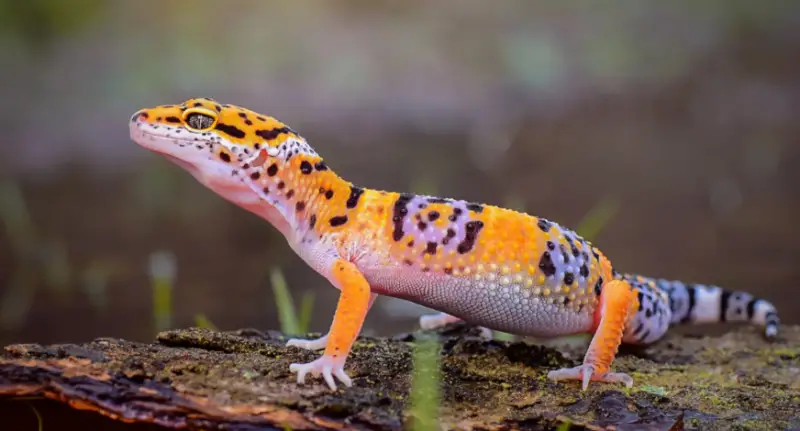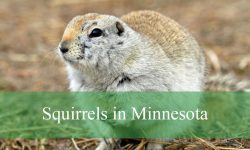Leopard geckos (Eublepharis macularius) are one of the most popular pet reptiles due to their docile nature, striking patterns, and relatively simple care requirements. If you are considering adopting one, a crucial question arises: How big will a leopard gecko get?
In this article, we will explore the growth stages of a leopard gecko, factors that influence their size, and essential care tips to ensure their optimal development.
How Big Do Leopard Geckos Get?

Leopard geckos typically reach their full adult size between 12 to 18 months of age. Their final size depends on various factors, including genetics, diet, and environmental conditions. Below is an overview of their size at different life stages:
Hatchling Stage (0-2 Months)
Size & Weight
At this early stage, leopard gecko hatchlings typically measure between 3 to 4 inches (7.5 to 10 cm) in length. Their weight ranges from 2 to 5 grams, though individual growth rates may vary depending on diet, genetics, and environmental conditions.
Growth Rate
Hatchlings experience rapid growth during their first two months of life. With proper nutrition and care, they can gain weight quickly, sometimes doubling in size within just a few weeks. However, any signs of stunted growth or weight loss may indicate improper husbandry or health issues.
Care Tips
Providing the right care during this delicate stage is crucial for the gecko’s long-term health and development.
-
Diet & Nutrition:
Hatchlings require a high-protein diet consisting of appropriately sized live insects, such as pinhead crickets, small mealworms, and flightless fruit flies. These should be gut-loaded (fed nutritious food) and dusted with calcium and vitamin supplements to prevent metabolic bone disease. Feed hatchlings daily, offering as many insects as they can consume within 10-15 minutes. -
Temperature & Enclosure Setup:
A well-maintained temperature gradient is essential for digestion and overall health. The warm side of the enclosure should be kept between 88-92°F (31-33°C), while the cool side should stay around 75-80°F (24-27°C). A heat mat regulated by a thermostat is the best way to achieve stable temperatures. Avoid heat lamps that may dry out the enclosure and stress the hatchling. -
Hydration & Humidity:
Although leopard geckos are desert reptiles, hatchlings still need adequate hydration. Always provide a shallow water dish with fresh, clean water. Additionally, a humid hide with moist sphagnum moss or paper towels should be included to aid in shedding and prevent dehydration. Ideal humidity levels should range from 30-40%, with slightly higher humidity in the hide. -
Handling & Interaction:
Hatchlings are delicate and may be skittish. Limit handling for the first few weeks to reduce stress and allow them to acclimate to their new environment. Once they appear comfortable, introduce short, gentle handling sessions to build trust. Always support their body and avoid grabbing their tail, as leopard geckos can drop it as a defense mechanism.
Juvenile Stage (2-6 Months)
Size & Weight
During the juvenile stage, leopard geckos experience steady growth, reaching a length of 5 to 7 inches (12.5 to 18 cm) and a weight of 10 to 30 grams. Their growth rate, while still significant, begins to slow compared to the hatchling stage. Proper nutrition and habitat conditions remain crucial to ensure they develop into healthy adults.
Growth Rate
The growth rate at this stage is moderate, with juveniles gaining weight gradually. A well-balanced diet and optimal environmental conditions contribute to strong bone development, muscle growth, and a robust immune system. Any noticeable delays in growth or weight gain may indicate inadequate nutrition, improper temperatures, or underlying health issues.
Care Tips
-
Diet & Nutrition:
Juvenile leopard geckos require a diet rich in protein, consisting of appropriately sized live insects such as:- Crickets (gut-loaded for better nutrition)
- Mealworms (offered in moderation, as they have a higher fat content)
- Small Dubia Roaches (an excellent staple due to their high protein and low fat levels)
Feeding should occur every day or every other day, with portions based on the gecko’s appetite. Juveniles tend to eat more than adults due to their rapid development. Calcium and vitamin supplementation remain essential to prevent metabolic bone disease (MBD). Dust insects with calcium powder (with D3) 2-3 times a week and use a multivitamin supplement once a week.
-
Temperature & Enclosure Setup:
Maintaining the correct temperature gradient ensures proper digestion and activity levels:- Warm side: 88-92°F (31-33°C)
- Cool side: 75-80°F (24-27°C)
- Nighttime temperatures: Can drop slightly but should not go below 70°F (21°C)
A heat mat controlled by a thermostat is the best method for providing belly heat, which aids digestion. Avoid heat lamps that may dry out the enclosure or cause excessive light exposure, which can stress the gecko.
-
Hydration & Humidity:
Fresh, clean water should always be available in a shallow dish. A humid hide with damp sphagnum moss or moist paper towels is crucial for aiding in shedding and preventing dehydration. Humidity levels should be 30-40%, with slightly higher humidity inside the humid hide. -
Handling & Socialization:
By this stage, juvenile leopard geckos are more comfortable with handling, but patience is still required.- Gradually increase handling sessions to help them get accustomed to human interaction.
- Always support their entire body and avoid sudden movements to prevent stress.
- Never grab their tail, as they can drop it as a defense mechanism.
-
Shedding & Skin Care:
Juveniles shed their skin every 2-4 weeks. Providing a humid hide and ensuring proper hydration helps facilitate smooth shedding. If retained shed is noticed on toes or tail tips, a gentle warm soak or the use of a damp cotton swab can help remove it.
Sub-Adult Stage (6-12 Months)
Size & Weight
At this stage, leopard geckos continue to grow but at a slower pace compared to their juvenile phase. They typically reach a length of 7 to 9 inches (18 to 23 cm) and weigh between 30 to 50 grams. Growth is still noticeable but gradually stabilizes as they approach adulthood.
Growth Rate
The growth rate during this period is slower but steady. While sub-adults continue to gain weight and muscle mass, their rapid development from the hatchling and juvenile stages begins to plateau. Proper nutrition, supplementation, and a well-maintained habitat remain crucial to ensure strong bone density, healthy organ function, and an active metabolism.
Care Tips
-
Diet & Nutrition:
At this stage, leopard geckos can transition to an adult feeding schedule, which means feeding every other day rather than daily. Their diet should remain protein-rich, consisting of a variety of live insects, such as:- Crickets (gut-loaded for optimal nutrition)
- Mealworms (offered in moderation)
- Dubia Roaches (high in protein and easy to digest)
- Superworms (larger but should be given in moderation due to higher fat content)
Occasional treats can be introduced, such as:
- Waxworms (high in fat, should be fed sparingly—no more than once a week)
- Hornworms (great for hydration but should also be given in moderation)
Calcium and vitamin supplementation remains essential:
- Calcium with D3: 2-3 times a week
- Multivitamin supplement: Once a week
-
Temperature & Enclosure Setup:
Proper temperature regulation is crucial for digestion and metabolic processes. The ideal temperature gradient should be maintained as follows:- Warm side: 88-92°F (31-33°C)
- Cool side: 75-80°F (24-27°C)
- Nighttime temperatures: Should not drop below 70°F (21°C)
A heat mat with a thermostat remains the best heating method. Sub-adult geckos are more active, so providing a spacious enclosure with hides, climbing structures, and enrichment helps encourage natural behaviors.
-
Hydration & Humidity:
Always provide fresh, clean water in a shallow dish. The humid hide remains essential, especially during shedding. Ideal humidity levels should be 30-40%, with slightly increased moisture inside the hide to assist in smooth shedding. -
Handling & Socialization:
By the sub-adult stage, leopard geckos are usually more tolerant of handling. Continue gentle handling sessions to reinforce trust. Always:- Support their body fully
- Avoid grabbing their tail
- Keep handling sessions brief if the gecko shows signs of stress
-
Shedding & Skin Care:
Shedding occurs every 3-5 weeks at this stage. Providing a humid hide and monitoring for any retained shed (especially around the toes and tail) ensures a smooth process. If retained shed is noticed, a warm soak or gentle rubbing with a damp cotton swab can help remove it.
Adult Stage (12+ Months)
Size & Weight
By the time a leopard gecko reaches adulthood, it typically measures between 7 to 11 inches (18 to 28 cm) in length and weighs 50 to 100 grams, depending on genetics, diet, and overall health. Some larger morphs, such as Giant and Super Giant variations, can exceed 100 grams with proper care.
Growth Rate
At this stage, growth slows significantly, with minimal increases in size and weight. Most adult geckos reach their full size by 12-18 months, but some may continue to gain a bit of weight until they are about 2 years old. Instead of growing, adults focus on maintaining muscle mass and overall health, making proper diet and weight monitoring essential.
Care Tips
-
Diet & Feeding Schedule:
Unlike hatchlings and juveniles that require daily feedings, adult leopard geckos eat less frequently. The recommended feeding schedule is 2-3 times per week. Their diet should still be protein-rich, consisting of a variety of live insects, such as:- Crickets (nutritious and readily available)
- Mealworms (moderation recommended due to higher fat content)
- Dubia Roaches (excellent staple food)
- Superworms (larger, should be fed occasionally)
Occasional Treats:
- Waxworms – High in fat, should only be given once a month to prevent obesity
- Hornworms – Great for hydration but should be an occasional snack
Supplementation:
- Calcium with D3: Dust insects 1-2 times a week
- Multivitamin supplement: Once a week
Overfeeding can lead to obesity, which is a common issue in adult geckos, especially those kept in captivity with limited activity. It’s important to monitor their weight and adjust feedings accordingly.
-
Temperature & Enclosure Setup:
A proper temperature gradient remains crucial for digestion and metabolic health:- Warm side: 88-92°F (31-33°C)
- Cool side: 75-80°F (24-27°C)
- Nighttime temperatures: Can drop slightly but should stay above 70°F (21°C)
Heating method: A heat mat controlled by a thermostat is the most effective way to maintain consistent temperatures. Heat lamps should only be used if needed but must not create excessive brightness, as leopard geckos are nocturnal and prefer dim lighting.
Enrichment & Space:
- Adults benefit from a larger enclosure (at least 20 gallons, but 30-40 gallons is ideal for better activity).
- Provide multiple hides (warm hide, cool hide, and humid hide).
- Add climbing structures and enrichment to encourage natural behaviors.
-
Hydration & Humidity:
Fresh water should always be available in a shallow dish. Maintaining 30-40% humidity is ideal, with a humid hide to aid shedding. -
Handling & Socialization:
Adult leopard geckos are typically more accustomed to handling if they were socialized properly from a young age. However, they still have individual personalities, and some may tolerate handling better than others. Always:- Support their entire body
- Avoid grabbing the tail
- Monitor stress levels (hissing, tail waving, or excessive squirming means they need a break)
-
Shedding & Skin Care:
Adults shed every 4-6 weeks. If retained shed is noticed, particularly on toes, tail tips, or eyes, provide a humid hide or a gentle warm soak to help remove it. -
Health Monitoring:
Regular health checks are essential to spot potential issues early. Watch for:- Sudden weight loss or gain
- Lethargy or lack of appetite
- Impaction symptoms (bloating, difficulty passing waste)
- Mouth rot, respiratory infections, or retained shed
Factors Affecting Leopard Gecko Growth
Several factors influence how big a leopard gecko will get. Understanding these factors can help ensure your pet reaches its full potential size.
1. Genetics
Just like humans, leopard geckos inherit physical traits from their parents. Some morphs, such as Giant and Super Giant, are bred specifically for larger sizes.
2. Diet and Nutrition
Providing a nutrient-rich diet is essential for growth. Key dietary components include:
- High-quality feeder insects: Crickets, mealworms, dubia roaches
- Calcium and vitamin D3 supplements: Prevents metabolic bone disease (MBD)
- Gut-loaded insects: Ensures geckos receive proper nutrients from their food
3. Temperature and Environment
Leopard geckos rely on external heat sources for digestion and metabolism. Maintaining an ideal temperature range is crucial:
- Warm side: 88-92°F (31-33°C)
- Cool side: 75-80°F (24-27°C)
- Nighttime: No lower than 70°F (21°C)
- Humidity: 30-40% to prevent respiratory infections
4. Enclosure Size
A properly sized enclosure ensures that a leopard gecko has enough space to explore, hunt, and exercise. Minimum recommendations:
- Single gecko: 10 to 20-gallon tank
- Multiple geckos: 20 to 40-gallon tank (only females should be housed together, as males will fight)
5. Health and Disease Prevention
Common health issues that can affect growth include:
- Metabolic Bone Disease (MBD): Caused by calcium deficiency
- Impaction: Resulting from ingesting loose substrate
- Parasites: Can lead to weight loss and stunted growth
How to Ensure Your Leopard Gecko Grows to Its Full Size
To help your leopard gecko reach its maximum potential, follow these care tips:
1. Provide a Nutrient-Dense Diet
- Feed a variety of insects to provide balanced nutrition.
- Use calcium and vitamin supplements as recommended.
2. Maintain Proper Temperature and Humidity
- Use a heat mat with a thermostat to regulate temperature.
- Provide hiding spots on both warm and cool sides.
3. Avoid Overfeeding and Obesity
- Juveniles should be fed daily, while adults can be fed 2-3 times a week.
- Remove uneaten insects to prevent stress.
4. Regular Health Checkups
- Observe for signs of illness such as lethargy, weight loss, or abnormal shedding.
- Visit a reptile vet if health concerns arise.
Frequently Asked Questions (FAQs)
1. What is the largest recorded size for a leopard gecko?
Some Super Giant morphs have been recorded reaching 12 inches (30 cm) and weighing over 120 grams.
2. How can I tell if my leopard gecko is underweight?
A healthy leopard gecko should have a plump tail, as they store fat there. If the tail appears thin or the body looks bony, it may be underweight.
3. Can a leopard gecko stop growing due to stress?
Yes, stress from improper handling, inadequate diet, or poor environmental conditions can stunt growth.
4. Do male and female leopard geckos grow to different sizes?
Yes, males tend to be larger, averaging 8-11 inches, while females usually range from 7-9 inches.
Conclusion
Understanding how big a leopard gecko will get is crucial for providing the best care possible. By ensuring a balanced diet, optimal environment, and proper health care, you can help your leopard gecko reach its full potential size and live a long, healthy life. Whether you have a standard morph or a Giant variety, responsible husbandry is key to their well-being.






